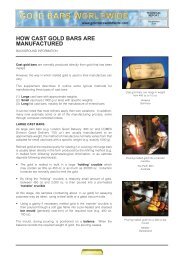Indian Gold Book:Indian Gold Book - Gold Bars Worldwide
Indian Gold Book:Indian Gold Book - Gold Bars Worldwide
Indian Gold Book:Indian Gold Book - Gold Bars Worldwide
You also want an ePaper? Increase the reach of your titles
YUMPU automatically turns print PDFs into web optimized ePapers that Google loves.
GOLD SUPPLY AND DEMAND<br />
The trade attribute static net demand to some inhibiting factors. For example, expenditure on lifestyle products increased<br />
at the expense of gold jewellery. More old gold jewellery was recycled. Among large retailers in major cities, the sale of<br />
diamond jewellery increased. The static rupee gold price weakened gold’s private investment dimension. Importantly, the<br />
rural economy was relatively depressed.<br />
GROSS FABRICATION AND DEMAND<br />
<strong>Gold</strong> jewellery<br />
When exchange and buy-backs for cash are taken into account, the gross fabrication of gold jewellery increases<br />
dramatically.<br />
In 2001, when net fabrication was 583 tonnes, gross fabrication appears to have been around 955 tonnes.<br />
Although the gross estimate can only be indicative, it can be recognised that a small decrease in gross fabrication,<br />
alongside a small increase in exchange and buy-backs, can result in a large decrease in net fabrication. And vice versa.<br />
Example<br />
Assume that gross fabrication over a period of 3 months is normally 300 tonnes, and exchange/buy-backs feed 40% so that<br />
net fabrication is 180 tonnes.<br />
If gross fabrication falls by 10% (30 tonnes) to 270 tonnes, and exchange/buy-backs feed 50% (135 tonnes), net<br />
fabrication would fall by 25% to 135 tonnes.<br />
This scenario is relevant to the first quarter of 2002. When the rupee gold price increased unexpectedly by 10 – 15%, net<br />
fabrication (and imports) fell by more than 50%, while gross fabrication (and demand) appeared to fall by only around<br />
15 - 20%.<br />
Total domestic market<br />
Gross demand for gold in 2001 is estimated at 1,053 tonnes: jewellery (91%), industrial (4%), coins (3%) and net bar<br />
hoarding (2%).<br />
Two important points can be made.<br />
• Jewellery retailers tend to refer to quantities of gold in carat (not fine) gold terms. In carat terms, for example, the<br />
market would be around 1,200 tonnes assuming an average actual caratage of K20.<br />
• The market does not make structural sense, and the comments of retailers also do not make sense, unless the extent<br />
of gross demand is taken into account.<br />
The indicative gross demand estimate of 1,053 tonnes explains why there are approximately 300,000 jewellery retailers,<br />
2 million active goldsmiths and 10,000 refiners.<br />
It puts high tonnages of industrial fabrication (4%), coin fabrication (3%) and net bar hoarding (2%) into perspective.<br />
Jewellery accounts for around 90% of the gross market.<br />
It also makes sense of trade estimates that the total market is well over 1,000 tonnes in carat terms, in some cases<br />
estimated at 2,000 tonnes.<br />
It also explains why net demand (and imports) fell so much more than gross demand in the first six months of 2002.<br />
Total imports<br />
This section has focused on supply and demand within the domestic market. In the appendix, “Total gold imports”,<br />
reference is made to gold imported for re-export as jewellery.<br />
When these imports are combined with those for the domestic market, total annual imports ranged between 700 – 727<br />
tonnes over the 4-year period 1998 – 2001.<br />
When indicative gold jewellery fabrication in 2001 for the domestic market (955 tonnes) is combined with that for export<br />
(54 tonnes), India fabricated more than 1,000 tonnes of gold jewellery.<br />
AN INTRODUCTION TO THE INDIAN GOLD MARKET 169

















